VW_TL_244 锌镍铝涂层表面防护要求_2010-12_ch2
- 格式:pdf
- 大小:273.38 KB
- 文档页数:8
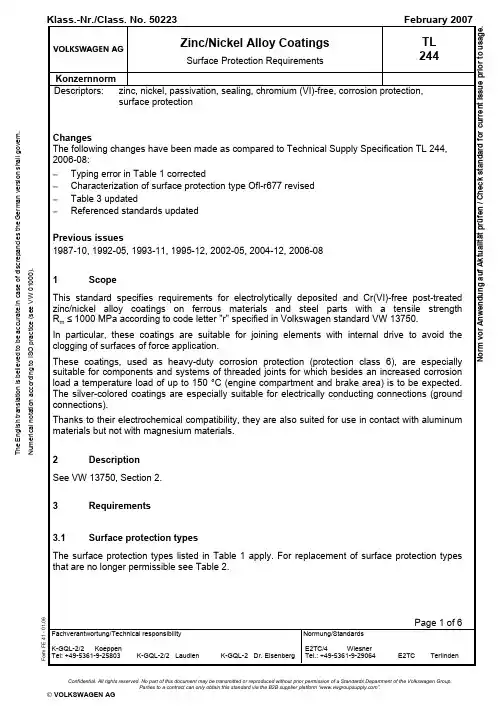
Confidential. All rights reserved. No part of this document may be transmitted or reproduced without prior permission of a Standards Department of the Volkswagen Group.Parties to a contract can only obtain this standard via the B2B supplier platform “”.VOLKSWAGEN AGF o r m F E 41 - 01.06T h e E n g l i s h t r a n s l a t i o n i s b e l i e v e d t o b e a c c u r a t e .I n c a s e o f d i s c r e p a n c i e s t h e G e r m a n v e r s i o n s h a l l g o v e r n .N u m e r i c a l n o t a t i o n a c c o r d i n g t o I S O p r a c t i c e (s e e V W 01000).Page 2TL 244: 2007-02Table 1Protection type Characteristics and appearanceOfl-r642 Zinc/nickel coating, Cr(VI)-free passivated (silver-colored to soft bluishiridescence)Ofl-r643 Zinc/nickel coating, Cr(VI)-free passivated and additionally sealed (silver-colored to soft bluish iridescence)Ofl-r645 As for Ofl-r643, but with additional lubricant treatment acc. toTL 52132Ofl-r649 1)Zinc/nickel coating, silver-colored, deposited from weakly acidicelectrolytes, Cr(VI)-free passivated, additionally sealed (silver-colored,only for castings, e.g. brake calipers)Ofl-r672 Zinc/nickel coating, deposited from alkaline electrolytes, black Cr(VI)-free passivatedOfl-r673 Zinc/nickel coating, black Cr(VI)-free passivated and additionally sealed Ofl-r677 As for Ofl-r673, but with additional lubricant treatment acc. to TL 52132 1) The use of weakly acidic electrolytes is to be coordinated with the departments K-GQL-2/2 and/or I/GQ-32Table 2Surface protection type no longer permittedfor new designs Replacement surface protection type fornew designsOfl-r640 Ofl-r643Ofl-r650 Ofl-r642 Ofl-r660 Ofl-r642 Ofl-r665 Ofl-r645 Ofl-r670 Ofl-r6731)Ofl-r675 Ofl-r6771) For screws with micro-encapsulated adhesive coating acc. to DIN 267-27, screws with locking coating acc. to DIN 267-28 andin steel construction, Ofl-r672 shall be used.3.2 GeneralrequirementsHigh-strength steel parts with a tensile strength Rm > 1 000 MPa and joining elements (e.g. screws) with a surface hardness > 320 HV must not be coated with these alloy coatings. Sheet metal screws and screws for thermoplasts are an exception to this.NOTE: Surface-protection types with sealing may impair the paintability.These coatings are also unsuitable for sealing elements on gas-carrying systems such as the air-conditioning system, because the coatings contain micro-cracks.Subsequent plastic deformation (flaring, pinching, bending) of components coated in this manner must be avoided, as this could damage the corrosion protection and thus reduce the component's corrosion resistance.Approval of first supply and changes according to VW 01155.Avoidance of hazardous substances according to VW 91101.Page 3TL 244: 2007-0210 finished parts are required for complete testing.Unless certain sections of a part that are marked in the drawing are excluded from the surface coating, the entire surface of the parts must comply with the required surface protection type and display the prescribed properties. The coatings shall adhere firmly to the base material.The production process and its control shall not impair the functional characteristics of the finished part.The protective coatings must not exhibit any pores, cracks, damage, or other flaws that impair the corrosion protection and/or specified appearance.Given proper mounting, the coating shall not be damaged if this would lead to impairment of function and/or decrease of the specified corrosion protection.The surface treatment procedure shall be conducted so that damage by delayed brittle fractures (hydrogen embrittlement) can be ruled out. Verification by the bracing test according to DIN 50969 in the first-sample test report.elements3.3 JoiningIn the case of metric threaded parts, the coating must not result in the h-position being exceeded in the case of external threads or the H-position being fallen below in the case of internal threads (see VW 11611).In the case of screws, the test requirements listed below only apply to the head and/or the wrench bearing surfaces; in the case of nuts, they apply only to the nut body without threaded area, and in the case of quick fastening elements to the body. For threaded and thread-like shaped parts, such as tap end studs, the test requirements only apply to the face surfaces.The reduced requirements according to Section 3.11 apply to process-related weak spots of the coating on joining elements such as the shank and the thread as well as to quick fastening elements.Furthermore, the specifications in DIN EN ISO 4042 concerning the maximum possible thickness of the electroplated coating in the threaded profile shall be taken into consideration.Joining elements with metric threads shall be treated with lubricants according to TL 52132 in order to ensure constant coefficients of friction. The coefficients of friction are tested according to VW 01129.3.4 Zinc/nickelprocesscoatingFor components with geometrically complicated shapes, the coatings deposited from alkaline systems are especially suitable. These coatings display a uniform nickel distribution over the entire current-density range.Except for Ofl-r649, all zinc/nickel coatings described are deposited from alkaline electrolytes. Ofl-r649 is deposited from weakly acidic electrolytes.If direct deposition from alkaline zinc/nickel electrolytes, e.g. on cast materials, is possible only under unfavorable conditions, the surface may be activated by deposition of a pre-zinc coating from a weakly acidic zinc electrolyte. The use of such a 2-layer system as well as the electrolytes used must be agreed upon by the Volkswagen Group Central Laboratory (K-GQL-2/2) and/or the Audi Group Test Laboratory (I/GQ-32).layers3.5 Cr(VI)-freeconversionIn order to improve the corrosion resistance of electrolytically deposited zinc/nickel coatings to salt water and condensed water, a post-treatment in passivation treatment solutions is required.The passivation treatment solution must not contain any Cr(VI) compounds in order to ensure that the resultant conversion layers are likewise Cr(VI)-free.Page 4TL 244: 2007-023.6 Post-treatmentsAs the outer appearance of the parts must not be impaired by strong color variations (iridescence), especially for parts in areas visible to the customer, a sealing post-treatment of the conversion layer must be performed depending on the surface protection type. This results also in an improvement of the corrosion protection.Organic polymers, inorganic protective layers or mixtures of the two, which can also contain inorganic and/or organic lubricants if necessary, can be used for sealing.The thickness of the layer structure can be increased slightly by the additional sealing, but this must not impair the functionality of the surface.If besides the corrosion protection further functional surface characteristics such as paintability, compatibility with agents, sliding properties, threading behavior, vulcanizability, temperature behavior or electrical conductivity are required, part-specific tests or functional tests shall be performed.The post-treatments must not cause any impairments such as unsightly drop-like residues resulting from crystallization and/or formation of a film on the part surface.material3.7 BaseSee drawing.3.8 NickelcontentX-ray fluorescence test method using measurement devices based on DIN EN ISO 3497.In cases of arbitration, testing according to PV 1214 and/or PV 1216 is performed.Requirement for Ofl-r642, Ofl-r643, Ofl-r645, Ofl-r672, Ofl-r673 and Ofl-r677: 12% to 16% Requirement for Ofl-r649: 10% to 18%.In exceptional cases, exclusively for castings (e.g. brake caliper), a nickel content of 12% to 17% is permissible for deposits from an alkaline electrolyte system.3.9 Electroplated coating thicknessesTesting according to DIN EN ISO 1463, DIN EN ISO 2178 and DIN EN ISO 3497 (see Section 4). Requirement: 8 µm to 25 µm (for components of a general nature),8 µm to 15 µm (for threaded parts, measuring point acc. to DIN EN ISO 4042).Page 5TL 244: 2007-02 3.10 AdhesivestrengthThermal shock test based on DIN EN ISO 2819.The specimen part is aged for 30 minutes at (300 ± 10) °C and then dipped in water with a temperature of 15 °C to 25 °C.Requirement: no bubble-shaped or large-scale stripping of the zinc coating.3.11 CorrosionbehaviorThe corrosion resistance of the systems must be ensured in the as-received condition and also after a 24-hour period of aging at an elevated temperature of 120 °C. These are minimum requirements and shall always be adhered to.Test method NSS acc. to DIN EN ISO 9227, assessment acc. to DIN EN 12329.The test durations and requirements according to Table 3 apply to the evaluation of the passivation treatment layers and to the sealing.The following applies to the evaluation of the zinc/nickel coatings, the passivation treatment layers and sealing:─No base metal corrosion after a test duration of 720 h for all surface protection types according to TL 244.─No zinc corrosion after the test durations specified in Table 3.The following applies to the evaluation of the shank and thread areas of threaded and quick fastening elements:─No base metal corrosion after a test duration of 480 h.Table 3 - Test durations and requirements for the evaluation ofpassivation treatment layers and sealingTest duration in hSurfaceprotection typeBarrel-galvanizedgoods 1)Rack-galvanizedgoodsRequirementOfl-r642 Ofl-r672 12096144-Ofl-r649 2)- 120 Ofl-r643Ofl-r645 Ofl-r673 Ofl-r677 144240240144-No zinc corrosion after the prescribed test duration,minor visual changes ("gray cast") without avoluminous character permissible.1) Barrel-galvanized goods are small parts which cannot be coated as rack-galvanized goods because of their shape, and whichtherefore are coated as bulk goods.2) Not intended for barrel-galvanized goods.4 Note on testing for measurement of coating thicknessA coating thickness measurement device based on the X-ray fluorescence measuring procedure according to DIN EN ISO 3497 (e.g. Fischerscope device from Helmut Fischer GmbH & Co., Germany) that allows the measurement of the coating thickness and the nickel content at the same time is used.Page 6TL 244: 2007-02The measuring duration is chosen so that repeat accuracy is lower than or equal to 0,5 weight percent nickel. Repeat accuracy is defined as the standard deviation of measured values under repeat conditions (same observer, same equipment, same specimen with same measuring point, short intervals between measurements).Measurement of coating thickness is performed by means of the magnetic/inductive method according to DIN EN ISO 2178 applying a probe. For specimens with a rough surface, several individual measurements (at least 5) shall be performed on the reference surface. The measuring result indicates the local coating thickness. The measuring equipment shall be tested by comparative testing at regular intervals or prior to a measurement series.standards15 ReferencedPV 1214 Zinc or Nickel Alloy Coatings; Determination of Nickel ContentPV 1216 Zinc or Nickel Alloy Coatings; Determination of Nickel Content Using ICP-OESTL 52132 Lubricant for Threaded Fastening Elements with Electrolytically Applied Coatings or those of Stainless Steel; RequirementsVW 01129 Limit Values for Coefficients of Friction; Mechanical Joining Elements with Metric ISO ThreadVW 01155 Vehicle Supply Parts; Approval of First Supply and ChangesVW 11611 Metric ISO Threads; Limit Dimensions with Surface Protection Layer for Medium Tolerance Class 6g/6HVW 13750 Surface Protection of Metal Parts; Surface Protection Types, CodesVW 91101 Environmental Standard for Vehicles; Vehicle Parts, Materials, Operating Fluids; Avoidance of Hazardous SubstancesDIN 50969 Testing of High-Strength Steel Building Elements for Resistance to Hydrogen-Induced Brittle Fracture and Advice on the Prevention of SuchFractureDIN EN 12329 Corrosion Protection of Metals – Electrodeposited Coatings of Zinc with Supplementary Treatment on Iron and SteelDIN EN ISO 1463 Metallic and Oxide Coatings – Measurement of Coating Thickness – Microscopical MethodDIN EN ISO 2178 Non-Magnetic Coatings on Magnetic Substrates –Measurement of Coating Thickness – Magnetic MethodDIN EN ISO 2819 Metallic Coatings on Metallic Substrates – Electrodeposited and Chemically Deposited Coatings – Review of Methods Available for Testing AdhesionDIN EN ISO 3497 Metallic Coatings – Measurement of Coating Thickness – X-Ray Spectrometric MethodsDIN EN ISO 4042 Fasteners – Electroplated CoatingsDIN EN ISO 9227 Corrosion tests in artificial atmospheres - Salt spray tests1 In this Section, terminological inconsistencies may occur as the original titles are used.。
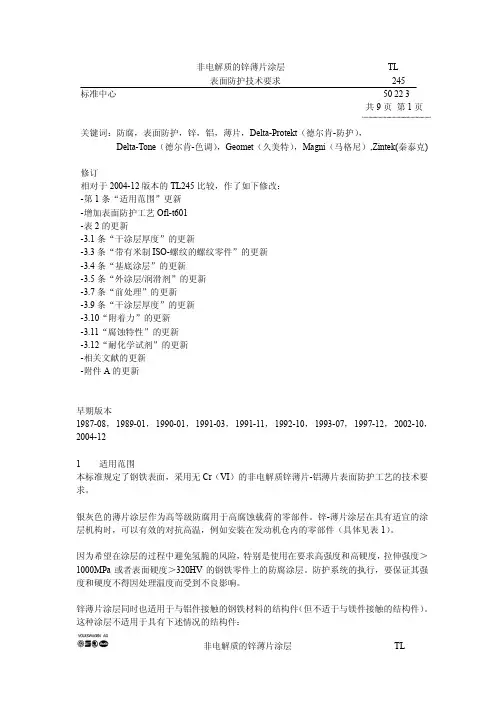
非电解质的锌薄片涂层TL表面防护技术要求245标准中心50 22 3共9页第1页关键词:防腐,表面防护,锌,铝,薄片,Delta-Protekt(德尔肯-防护),Delta-Tone(德尔肯-色调),Geomet(久美特),Magni(马格尼),Zintek(秦泰克)修订相对于2004-12版本的TL245比较,作了如下修改:-第1条“适用范围”更新-增加表面防护工艺Ofl-t601-表2的更新-3.1条“干涂层厚度”的更新-3.3条“带有米制ISO-螺纹的螺纹零件”的更新-3.4条“基底涂层”的更新-3.5条“外涂层/润滑剂”的更新-3.7条“前处理”的更新-3.9条“干涂层厚度”的更新-3.10“附着力”的更新-3.11“腐蚀特性”的更新-3.12“耐化学试剂”的更新-相关文献的更新-附件A的更新早期版本1987-08,1989-01,1990-01,1991-03,1991-11,1992-10,1993-07,1997-12,2002-10,2004-121适用范围本标准规定了钢铁表面,采用无Cr(VI)的非电解质锌薄片-铝薄片表面防护工艺的技术要求。
银灰色的薄片涂层作为高等级防腐用于高腐蚀载荷的零部件。
锌-薄片涂层在具有适宜的涂层机构时,可以有效的对抗高温,例如安装在发动机仓内的零部件(具体见表1)。
因为希望在涂层的过程中避免氢脆的风险,特别是使用在要求高强度和高硬度,拉伸强度>1000MPa或者表面硬度>320HV的钢铁零件上的防腐涂层。
防护系统的执行,要保证其强度和硬度不得因处理温度而受到不良影响。
锌薄片涂层同时也适用于与铝件接触的钢铁材料的结构件(但不适于与镁件接触的结构件)。
这种涂层不适用于具有下述情况的结构件:非电解质的锌薄片涂层TL表面防护技术要求245标准中心50 22 3共9页第2页-具有导电功能(例如,接地)-按VW01043<N8的内多齿和按按VW01048<T30的内六角-<5的内六边和<H3的按DIN EN ISO 4757处理的十字槽-<M6的外螺纹和<M10的内螺纹-厚度<1.6mm的盘状件锌薄片涂层只有在特殊情况下才使用在机组内腔(例如油腔),这时要避免溶解的涂层颗粒带来的问题。

2004年12月 锌/镍-合金镀层表面保护技术要求TL 244 标准中心 50 22 350 22 3后续2至6页 翻译 曹哲 日期 2005.11.10 校对 日期 打字 牛红珍日期2006.01.06关键词:锌、镍、钝化作用、封闭、不含铬(VI )、防腐蚀、表面保护修订:同TL 244:2002-05比较,做了如下更改:- 吸取了镀层类型Ofl-r649(用于铸件,例如制动器鞍形座)- 表3中试验时间有所规定- 相关参考文献有更新以前的版本1987-10; 1992-05; 1993-11; 1995-12 ; 2002-051 适用范围本标准为具有抗拉强度Rm ≤1000 MPa,按VW 137 50标上字母“r ”的钢铁材料及钢 质零件电解离析和不含铬(VI)、后加工的锌/镍合金镀层规定了技术要求.特别是,这种镀层也适用于具有内旋转方式的连接元件,使之避免作用力的损失.所采用的这种镀层,具有良好的抗锈防蚀的能力(稳定性等级为6级),特别适用于一些特定区域的结构件和螺栓连接组系.在这些区域里,除去较高的腐蚀负荷之外,还有高达 1500C (例如:发动机舱和制动器区间)的热负荷以及导电化合物(接地),这些实际问题都在期待着我们去解决.再补充一句,这种镀层依靠其电化学的兼容性,还可以用来接通铝材料工件,但不用于接 通磁性材料工件.2 标记法见VW 137 50,第2条3 技术要求3.1 镀层类型当前使用的镀层类型列举在表1中,不再使用的镀层类型见表2.第 2 页TL 244: 2004 - 12表1镀层类型镀层的特征和外观Ofl-r642 锌/镍镀层,由含碱电解液沉积而成,钝化成无色,不含Cr(VI),(外观透亮、直至淡兰色、彩虹色为止)Ofl-r643 锌/镍镀层,由含碱电解液沉积而成,钝化成无色,不含Cr(VI),并补加保护层.(外观透亮、直至淡兰色、彩虹色为止)Ofl-r645 如同Ofl-r643,不过补加了润滑剂处理(见VW 01110)Ofl-r649 1)锌/镍镀层,由弱酸电解液沉积而成,钝化成无色,不含Cr(VI),(只用于铸件,例如制动鞍形座)Ofl-r672 锌/镍镀层,由含碱电解液沉积而成,钝化成黑色,不含Cr(VI),Ofl-r673 锌/镍镀层,由含碱电解液沉积而成,钝化成黑色,不含Cr(VI),并补加保护层.Ofl-r677 如同Ofl-r672,不过补加了润滑剂处理(见VW 01110)1) 所使用的弱酸电解液,用K-GQ-32和/或I/GQ-32加以调整.表2不再用于新设计的镀层类型规定用于新设计的替代镀层类型Ofl-r640 Ofl-r643Ofl-r650 Ofl-r642Ofl-r660 Ofl-r642Ofl-r665 Ofl-r645Ofl-r670 Ofl-r672Ofl-r675 Ofl-r6773.2 基本技术要求具有抗拉强度Rm>1000 MPa的高强度钢零件和具有表面硬度>320 HV的连接元件(例如:螺栓)但不给配备合金镀层.涂(镀)层即不适用于气压系统的密封元件,也不适用于例如有微小缝隙的空气调节设备.某些事后的塑料变形(卷边,压伤,弯曲)对于镀层的结构件要力求避免,因为这些东西会造成防锈层的损坏和随之而来的降低抗腐能力.首批供货和更改的批准按VW 011 55.避免有害物质按VW 911 01.对于一次全面彻底的试验需用10件成品件.第 3 页TL 244: 2004 - 12 在图纸上,除去已标明表面涂层的零件部位之外,若尚有不明之处,则该零件还应就全表面范围指明其所需要的表面保护以及明文规定的性能.螺纹零件必须就镀膜情况指明相应公差位的某一膜层厚度.米制内螺纹零件按VW 116 24.米制外螺纹零件按VW 116 27,根据镀膜的实际情况,对外螺纹,h-位一般不会超过,而对内螺纹,H-位就不会不超过规定的尺寸范围.制造方法必须妥善规划和控制,保证制品的使用性能不致遭到削弱.防护层不得有气孔、裂纹、损伤以及类似的缺陷,这些缺陷对于防锈和/或书面规定的外观都是不利的.如果装配工作是符合专业要求的,就不会出现镀膜的损坏.须知这种损伤将导致功能的降低和/或规定的防锈能力的削弱.表面加工处理的工艺规程要很好地执行,务必排除滞后脆裂(氢脆)的损伤.该项检验按DIN 50 969进行.并在原始样品检验报告中写明.3.3 连接元件对于螺栓和快速固定元件而言,下面列出的试验技术要求,只适用于其端部和/或扳手平面.对于螺母而言,只适用于螺母体部而不包括其螺丝部分.对于螺丝和与螺丝相似的模制件,例如双头螺栓,该试验技术要求则只适用于其端面.对于与过程相关的薄弱环节,连接元件的镀膜,例如螺杆和螺纹的镀膜,就可以降低要求,按3.11条行事.此外还要注意,在DIN EN ISO 4042中的数据,是否超过了螺纹轮廓中最大可能的电镀层厚度.这些降低了的试验技术条件同样适用于快速固定元件.为了校准恒定的摩擦系数,米制螺纹连接元件必须用润滑剂按TL 521 32进行处理,摩擦系数的试验按VW 011 29进行.更进一步的说明见VW 01110标准第2条。

大众汽车集团标准TL 2442010年12月版分类号:50223关键字:锌,镍,钝化处理,密封,无Cr(VI),防腐蚀,表面保护锌/镍-合金涂覆层表面保护要求旧版本TL 244: 1987-10, 1992-05, 1993-11, 1995-12, 2002-05, 2004-12, 2006-08, 2007-02变更相对于 TL244: 2007-02 版本,作了如下更改:--补充了热处理后零件的抗拉强度≦ 1200Mpa 部分;--添加了 Ofl-r647 和 Ofl-r648 两种涂覆方法;--原表 2 中关于含铬的表面保护类型已删除;--添加了图 1 和图 2;--添加了 PV 1209,PV 1200 和 PV1210 三种测试依据;--镀层表面形态的要求有所增加;--镍的上限值有所改变;--原第 4 条关于镀层厚度的测量的内容加入到部分;--原部分的要求有所改变;--参考标准有更新;--标准重组。
1 范围本标准规定了抗拉强度为 Rm≦ 1000Mpa(按 VW 137 50 的特征字母 r)的铁材料和钢制件上的电解离析和无Cr( VI)后处理的锌/镍合金涂覆层的要求。
此外还定义了抗拉强度值大于 1000Mpa时的应用极限。
本标准定义了合金涂覆不适用于抗拉强度 Rm>1200Mpa 和表面硬度>370HV 的钢制件。
而且适用于抗拉强度值在 1000Mpa 和 1200Mpa之间的钢制件时,必须按 DIN EN ISO4042 作热处理。
这些当作坚固防腐层(稳定等级为 6)的涂覆层,亦特别适用于除了腐蚀负荷增加和温度负荷增加至150°C(例如:发动机室和刹车系统)之外的部件以及螺栓拧紧系统。
银色涂覆层(例如:Ofl-r642,Ofl-r643,Ofl-r645和Ofl-r647)特别适用于导线连接(接地线连接)。
这些涂覆层特别适用于内部传动的紧固元件,以避免附加的施力作用。
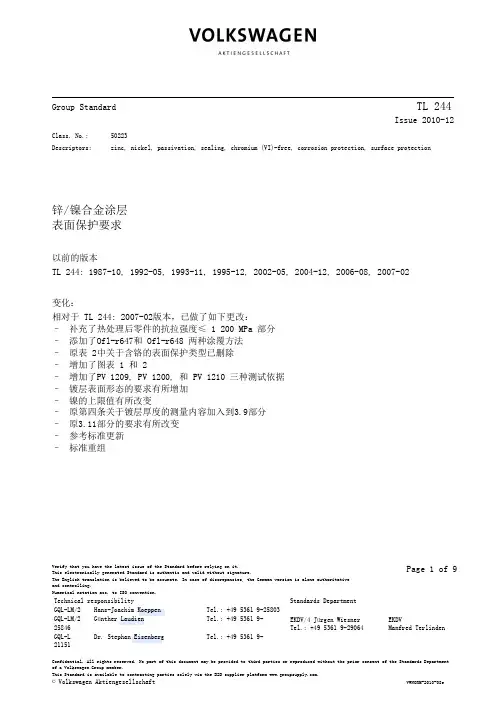
Group Standard TL 244Issue 2010-12 Class. No.: 50223Descriptors: zinc, nickel, passivation, sealing, chromium (VI)-free, corrosion protection, surface protection锌/镍合金涂层表面保护要求以前的版本TL 244: 1987-10, 1992-05, 1993-11, 1995-12, 2002-05, 2004-12, 2006-08, 2007-02变化:相对于 TL 244: 2007-02版本,已做了如下更改:– 补充了热处理后零件的抗拉强度≤ 1 200 MPa 部分– 添加了Ofl-r647和 Ofl-r648 两种涂覆方法– 原表 2中关于含铬的表面保护类型已删除– 增加了图表 1 和 2– 增加了PV 1209, PV 1200, 和 PV 1210 三种测试依据– 镀层表面形态的要求有所增加– 镍的上限值有所改变– 原第四条关于镀层厚度的测量内容加入到3.9部分– 原3.11部分的要求有所改变– 参考标准更新– 标准重组Verify that you have the latest issue of the Standard before relying on it.This electronically generated Standard is authentic and valid without signature.The English translation is believed to be accurate. In case of discrepancies, the German version is alone authoritativeand controlling.Numerical notation acc. to ISO convention.Technical responsibility Standards DepartmentGQL-LM/2 Hans-Joachim Koeppen Tel.: +49 5361 9-25803Page 1 of 9GQL-LM/2 Günther Laudien Tel.: +49 5361 9-25846GQL-L Dr. Stephan Eisenberg Tel.: +49 5361 9-21151 EKDV/4 Jürgen Wiesner EKDVTel.: +49 5361 9-29064 Manfred TerlindenConfidential. All rights reserved. No part of this document may be provided to third parties or reproduced without the prior consent of the Standards Department of a Volkswagen Group member.This Standard is available to contracting parties solely via the B2B supplier platform .© Volkswagen Aktiengesellschaft VWNORM-2010-08ePage 2TL 244: 2010-121 范围本规范规定了抗拉强度为RM≤1000Mpa(按VW137 50的特征字母r)的铁材料和钢制件上的电解离析和无铬含量(VI)后处理的锌/镍合金涂覆层的要求。
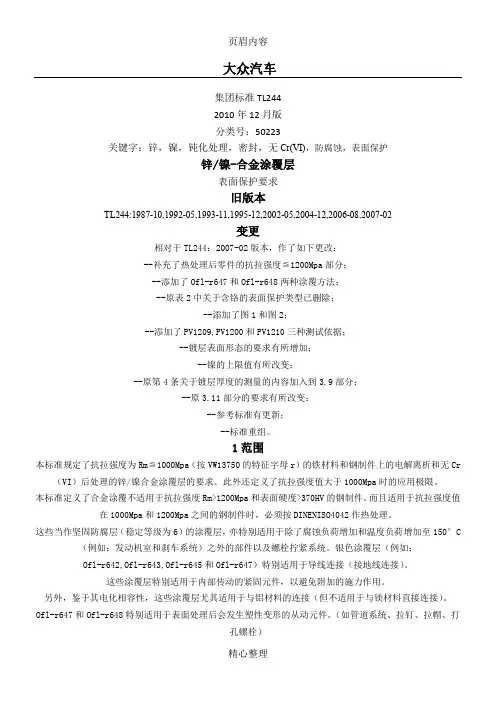
大众汽车集团标准TL2442010年12月版分类号:50223关键字:锌,镍,钝化处理,密封,无Cr(VI),防腐蚀,表面保护锌/镍-合金涂覆层表面保护要求Cr (在1000Mpa和1200Mpa之间的钢制件时,必须按DINENISO4042作热处理。
这些当作坚固防腐层(稳定等级为6)的涂覆层,亦特别适用于除了腐蚀负荷增加和温度负荷增加至150°C (例如:发动机室和刹车系统)之外的部件以及螺栓拧紧系统。
银色涂覆层(例如:Ofl-r642,Ofl-r643,Ofl-r645和Ofl-r647)特别适用于导线连接(接地线连接)。
这些涂覆层特别适用于内部传动的紧固元件,以避免附加的施力作用。
另外,鉴于其电化相容性,这些涂覆层尤其适用于与铝材料的连接(但不适用于与镁材料直接连接)。
Ofl-r647和Ofl-r648特别适用于表面处理后会发生塑性变形的从动元件。
(如管道系统、拉钉、拉帽、打孔螺栓)2标记方法参见VW13750,第2章节。
3技术要求3.1表面防护类型表面保护类型见表1:进行一次完整的试验需要10个成品件。
注1:采用封闭剂的表面保护类型,可能影响涂胶的附着性能。
由于其微裂性,这些涂覆层也不适合于诸如空调装置的供气系统的密封元件。
采用这种涂覆方法的部件,必须避免后来的塑性变形(卷边、挤压、弯曲),这是因为这种情况会导致损害防腐性能,从而降低防腐耐抗性。
Ofl-r647或Ofl-r648将优先运用于会发生塑性变形的零件。
Ofl-r647将优先应用于流体运载系统。
除非元件在图纸上特意标出不须涂覆,否则元件的全部表面必须依照所需的保护类型并表明其性质,涂覆层应牢牢的附着在基体材质上。
表面形态的一般注意事项:锌镍涂层零件表面粗糙度,除其他因素外,取决于锌镍电解液特性和组件的表面光洁度。
有涂层与无涂层之间的表面粗糙度相差必须≦Rz5um。
锌/镍涂覆的表面:由严重开裂引起的结瘤(如图1)会对品质产生负面影响(如剥落,防腐能力不足,元件在组装过程中无意识擦伤),所以必须要避免。
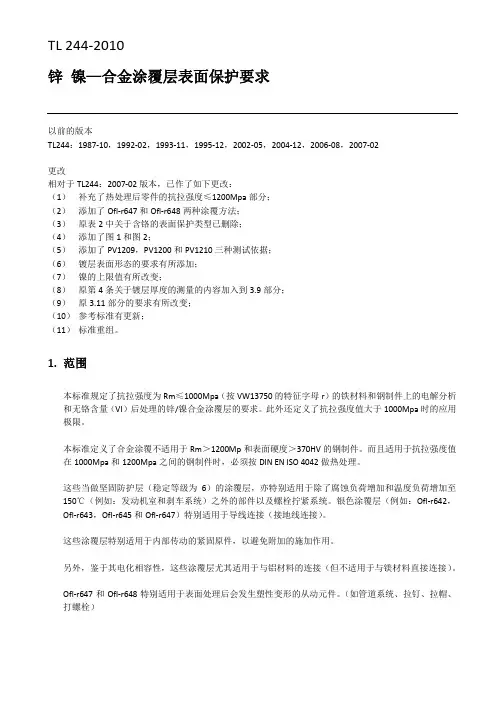
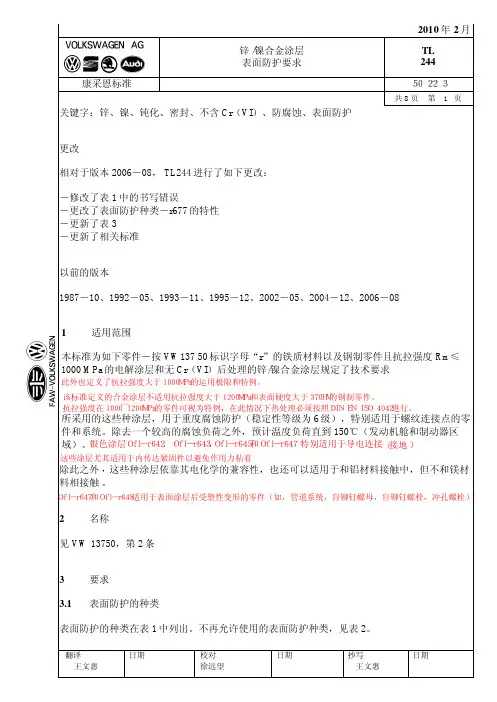
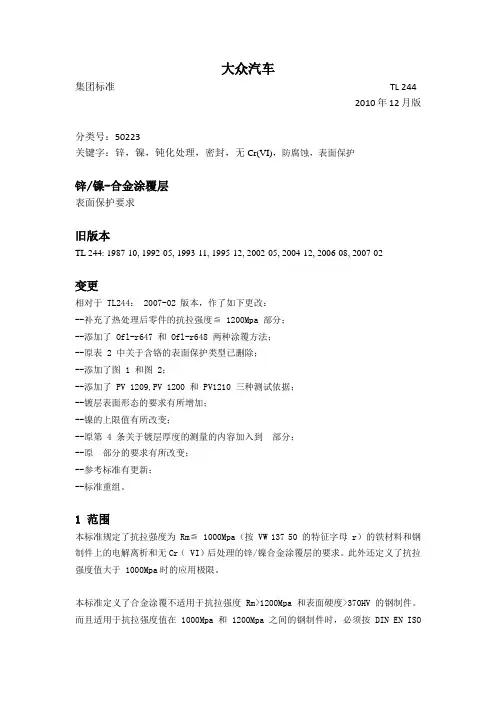
大众汽车集团标准TL 2442010年12月版分类号:50223关键字:锌,镍,钝化处理,密封,无Cr(VI),防腐蚀,表面保护锌/镍-合金涂覆层表面保护要求旧版本TL 244: 1987-10, 1992-05, 1993-11, 1995-12, 2002-05, 2004-12, 2006-08, 2007-02变更相对于 TL244: 2007-02 版本,作了如下更改:--补充了热处理后零件的抗拉强度≦ 1200Mpa 部分;--添加了 Ofl-r647 和 Ofl-r648 两种涂覆方法;--原表 2 中关于含铬的表面保护类型已删除;--添加了图 1 和图 2;--添加了 PV 1209,PV 1200 和 PV1210 三种测试依据;--镀层表面形态的要求有所增加;--镍的上限值有所改变;--原第 4 条关于镀层厚度的测量的内容加入到部分;--原部分的要求有所改变;--参考标准有更新;--标准重组。
1 范围本标准规定了抗拉强度为 Rm≦ 1000Mpa(按 VW 137 50 的特征字母 r)的铁材料和钢制件上的电解离析和无Cr( VI)后处理的锌/镍合金涂覆层的要求。
此外还定义了抗拉强度值大于 1000Mpa时的应用极限。
本标准定义了合金涂覆不适用于抗拉强度 Rm>1200Mpa 和表面硬度>370HV 的钢制件。
而且适用于抗拉强度值在 1000Mpa 和 1200Mpa之间的钢制件时,必须按 DIN EN ISO4042 作热处理。
这些当作坚固防腐层(稳定等级为 6)的涂覆层,亦特别适用于除了腐蚀负荷增加和温度负荷增加至150°C(例如:发动机室和刹车系统)之外的部件以及螺栓拧紧系统。
银色涂覆层(例如:Ofl-r642,Ofl-r643,Ofl-r645和Ofl-r647)特别适用于导线连接(接地线连接)。
这些涂覆层特别适用于内部传动的紧固元件,以避免附加的施力作用。
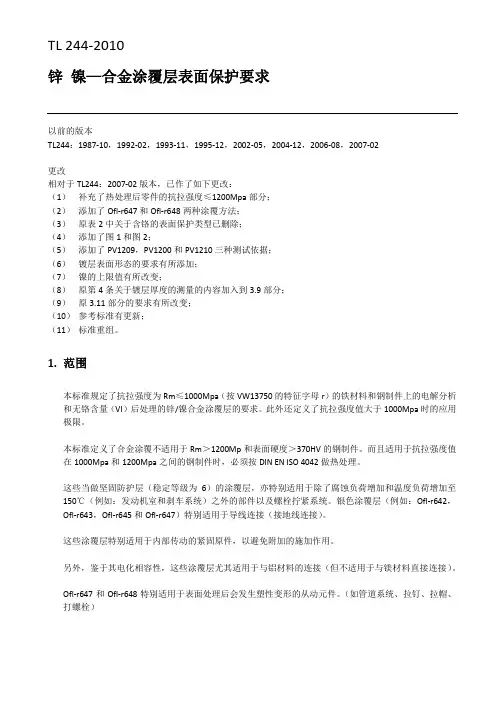
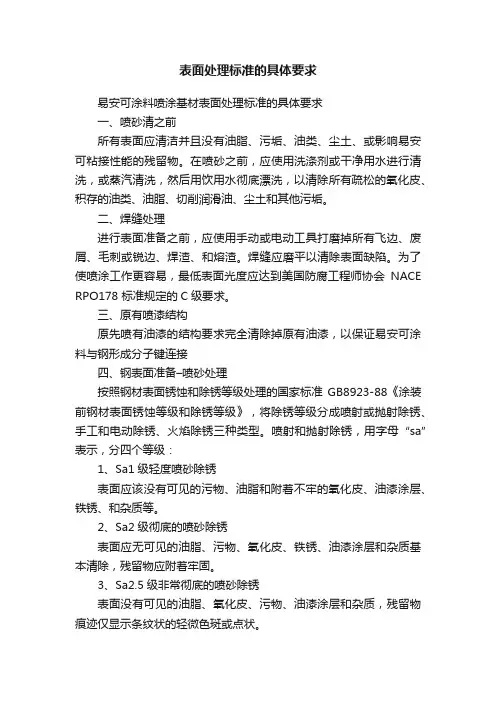
表面处理标准的具体要求易安可涂料喷涂基材表面处理标准的具体要求一、喷砂清之前所有表面应清洁并且没有油脂、污垢、油类、尘土、或影响易安可粘接性能的残留物。
在喷砂之前,应使用洗涤剂或干净用水进行清洗,或蒸汽清洗,然后用饮用水彻底漂洗,以清除所有疏松的氧化皮、积存的油类、油脂、切削润滑油、尘土和其他污垢。
二、焊缝处理进行表面准备之前,应使用手动或电动工具打磨掉所有飞边、废屑、毛刺或锐边、焊渣、和熔渣。
焊缝应磨平以清除表面缺陷。
为了使喷涂工作更容易,最低表面光度应达到美国防腐工程师协会NACE RPO178 标准规定的C级要求。
三、原有喷漆结构原先喷有油漆的结构要求完全清除掉原有油漆,以保证易安可涂料与钢形成分子键连接四、钢表面准备–喷砂处理按照钢材表面锈蚀和除锈等级处理的国家标准GB8923-88《涂装前钢材表面锈蚀等级和除锈等级》,将除锈等级分成喷射或抛射除锈、手工和电动除锈、火焰除锈三种类型。
喷射和抛射除锈,用字母“sa”表示,分四个等级:1、Sa1级轻度喷砂除锈表面应该没有可见的污物、油脂和附着不牢的氧化皮、油漆涂层、铁锈、和杂质等。
2、Sa2级彻底的喷砂除锈表面应无可见的油脂、污物、氧化皮、铁锈、油漆涂层和杂质基本清除,残留物应附着牢固。
3、Sa2.5级非常彻底的喷砂除锈表面没有可见的油脂、氧化皮、污物、油漆涂层和杂质,残留物痕迹仅显示条纹状的轻微色斑或点状。
4、Sa3级喷砂除锈至钢材表面洁净表面没有可见的油脂、污物、氧化皮、铁锈、油漆涂层和杂质,表面具有均匀的金属色泽。
易安可环保合金涂料要求喷涂前基材处理达到sa2.5级以上,并且表面粗糙度达到2-3 密耳。
喷砂用的压缩空气应没有水和油。
压缩空气系统中应有适当油/水分离器,以保证消除所有污染物。
可以用ASTM D4285标准试验方法检验压缩空气是否清洁。
方法是:将压缩空气通过一块白布喷出,如果在布上发现有任何油或水,则应清洗油/水分离器,直到随后进行的20秒试验证明能满足要求。
大众汽车集团标准TL2442010年12月版分类号:50223关键字:锌,镍,钝化处理,密封,无Cr(VI),防腐蚀,表面保护锌/镍-合金涂覆层表面保护要求旧版本变更相对于----添加了--原表2----添加了------原第4--原3.11----1范围Cr (VI在1000Mpa和1200Mpa之间的钢制件时,必须按DINENISO4042作热处理。
这些当作坚固防腐层(稳定等级为6)的涂覆层,亦特别适用于除了腐蚀负荷增加和温度负荷增加至150°C (例如:发动机室和刹车系统)之外的部件以及螺栓拧紧系统。
银色涂覆层(例如:Ofl-r642,Ofl-r643,Ofl-r645和Ofl-r647)特别适用于导线连接(接地线连接)。
这些涂覆层特别适用于内部传动的紧固元件,以避免附加的施力作用。
另外,鉴于其电化相容性,这些涂覆层尤其适用于与铝材料的连接(但不适用于与镁材料直接连接)。
Ofl-r647和Ofl-r648特别适用于表面处理后会发生塑性变形的从动元件。
(如管道系统、拉钉、拉帽、打孔螺栓)2标记方法参见VW13750,第2章节。
3技术要求3.1表面防护类型表面保护类型见表1:进行一次完整的试验需要10个成品件。
注1:采用封闭剂的表面保护类型,可能影响涂胶的附着性能。
由于其微裂性,这些涂覆层也不适合于诸如空调装置的供气系统的密封元件。
采用这种涂覆方法的部件,必须避免后来的塑性变形(卷边、挤压、弯曲),这是因为这种情况会导致损害防腐性能,从而降低防腐耐抗性。
Ofl-r647或Ofl-r648将优先运用于会发生塑性变形的零件。
Ofl-r647将优先应用于流体运载系统。
除非元件在图纸上特意标出不须涂覆,否则元件的全部表面必须依照所需的保护类型并表明其性质,涂覆层应牢牢的附着在基体材质上。
表面形态的一般注意事项:锌镍涂层零件表面粗糙度,除其他因素外,取决于锌镍电解液特性和组件的表面光洁度。
有涂层与无涂层之间的表面粗糙度相差必须≦Rz5um。
锌铝涂层涂覆工艺对螺栓摩擦特性影响的分析作者:高杰文来源:《中国科技博览》2015年第18期[摘要]本文主要具有专利属性的德国DELTA-MKS公司研制的DELTA经典无铬处理液作为研究对象,通过涂覆高强度螺栓进行了多组对比实验,并综合比较分析,得出了涂覆工艺影响总摩擦系数的相关规律。
为在涂覆工艺方面控制螺栓总摩擦系数作出了有益的探索。
[关键词]锌铝涂层,涂覆工艺,螺栓,总摩擦系数中图分类号:TG174.44 文献标识码:A 文章编号:1009-914X(2015)18-0325-03[Abstract]This paper presents the influence treads of the total friction coefficient during the coating processes, based on patented chrome-free coating solutions, which are developed by Delta-MKS company, with coated with high strength bolts,through multiple sets of comparative experiments and a comprehensive comparative analysis. It will be helpful to better control bolts friction coefficient in surface treatment process.引言:近年来,锌铝涂层因其优异的综合性能在汽车、电力、化工、海洋、铁路、桥梁、隧道、造船、国防军事等领域广为应用。
一般认为,表面处理种类,以及表面润滑状态是影响螺栓摩擦系数的最主要原因之一。
曹增强,林永福等人利用正交方法进行了理论上的论证[1]。
陈晓峰等人以达克罗螺栓和镀锌螺栓为例,对比分析了影响二者的摩擦系数和扭矩系数的稳定性的因素[2]。
镍铝复合带标准镍铝复合带是一种由镍和铝两种金属材料通过复合工艺制造而成的复合材料。
它具有高强度、抗蚀性能好、导热性能良好等优点,被广泛应用于电子、航空航天、能源等领域。
制定相关标准是为了确保镍铝复合带的质量和性能符合要求,在使用过程中能够安全可靠地发挥其功能。
一、镍铝复合带的材料要求1. 镍成分:镍的含量应符合国家标准,一般要求不低于99%。
2. 铝成分:铝的含量应符合国家标准,一般要求不低于99%。
3. 复合层:镍和铝的复合层应具有良好的结合性,不得出现分层、剥离等缺陷。
4. 厚度:镍铝复合带的厚度应符合设计要求,一般为0.1mm-2.0mm。
二、镍铝复合带的物理性能要求1. 抗拉强度:镍铝复合带的抗拉强度应符合国家标准,一般要求不低于250MPa。
2. 屈服强度:镍铝复合带的屈服强度应符合国家标准,一般要求不低于150MPa。
3. 伸长率:镍铝复合带的伸长率应符合国家标准,一般要求不低于10%。
4. 硬度:镍铝复合带的硬度应符合国家标准,一般要求达到HB100-HB200之间。
三、镍铝复合带的化学性能要求1. 耐腐蚀性:镍铝复合带应具有良好的耐腐蚀性,能够抵抗酸、碱、盐等化学介质的腐蚀。
2. 焊接性能:镍铝复合带应具有良好的焊接性能,能够与其他材料进行可靠的焊接。
3. 热稳定性:镍铝复合带应具有良好的热稳定性,能够在高温环境下保持稳定性能。
四、镍铝复合带的检验方法1. 外观检查:对镍铝复合带的外观进行检查,包括表面平整度、无气泡、无裂纹等。
2. 尺寸检查:对镍铝复合带的厚度、宽度、长度进行检查,检测是否符合设计要求。
3. 力学性能检测:包括抗拉强度、屈服强度、伸长率等的测定,通过拉伸试验等方法进行检测。
4. 化学成分分析:对镍铝复合带的镍、铝含量进行化学分析,确保其符合国家标准。
5. 耐腐蚀性测试:将镍铝复合带放入酸碱溶液中,测定其耐腐蚀能力。
五、镍铝复合带的包装和贮存要求1. 包装要求:镍铝复合带应采取防潮、防油污、防震动等措施进行包装,确保产品不受损。
BNC®水性无铬锌铝涂层BNC®水性无铬锌铝涂层无铬锌铝涂层是为满足世界各国的VOC法规和汽车行业规定的环保要求而开发出的表面处理新概念,无铬锌铝涂层作为锌铬涂层(达克罗)的更新换代产品已经首先被汽车制造行业普遍认可和接受。
一.防腐机理无铬锌铝涂层的外观呈亚光银灰色,光泽较锌铬涂层略暗,是一种将超细锌鳞片和铝鳞片叠合包裹在特殊粘结剂中的无机涂层。
无铬锌铝涂层从四个方面对钢铁基体提供保护作用。
1.屏障保护经过处理的层层叠合的锌鳞片和铝鳞片在钢铁基体和腐蚀介质之间提供了一道优良的屏障,阻碍了腐蚀介质和去极化剂到达基体;2.电化学作用锌层作为牺牲阳极被腐蚀以保护钢铁基体;3.钝化作用由于钝化而产生的金属氧化物减慢了锌及钢铁的腐蚀反应速度4.自修复作用当涂层受损时,锌的氧化物和碳酸盐向涂层被损坏的区域移动,积极地修复涂层,恢复保护屏障。
二.环境效益无铬锌铝涂层所采用水性涂料,不使用有机溶剂,不含有毒的金属(如镍、铅、钡和汞)以及六价铬或三价铬,符合美国环保署(EPA)、美国职业安全和健康行政部门(OSHA)的相应规范和世界各大汽车制造厂商的标准要求。
三.性能特点1.涂层薄无铬锌铝涂层的厚度通常为8-10μm;2.无氢脆涂覆过程不采用酸洗,避免了氢脆的产生;3.抗双金属腐蚀大多数锌层与铝或钢紧密配合时会产生典型的双金属微电池,而无铬锌铝涂层中的铝鳞片能够消除上述现象的发生。
4.耐有机溶剂作为一种无机涂层,能够耐受有机溶剂;5.耐热性涂层即使在3小时内300°C高温也保持优异耐蚀性;6.导电性涂层中叠合在一起金属锌、铝薄片允许电流通过并传导到基体;7.耐蚀性对于螺纹零件来说,8~10μm的无铬锌铝涂层可以耐72 0h盐雾试验不出现红锈;而对于非螺纹紧固则可以达800h。
单纯的无铬锌铝涂层的耐盐雾腐蚀性能稍逊于锌铬涂层,但在模拟真实自然环境的循环腐蚀试验中的表现与锌铬涂层相当。
四.涂覆工艺无铬锌铝涂层与锌铬涂层在涂覆生产工艺上是相近的。